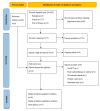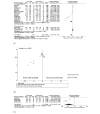Immersive and Nonimmersive Virtual Reality-Assisted Active Training in Chronic Musculoskeletal Pain: Systematic Review and Meta-Analysis
- PMID: 39159449
- PMCID: PMC11369537
- DOI: 10.2196/48787
Immersive and Nonimmersive Virtual Reality-Assisted Active Training in Chronic Musculoskeletal Pain: Systematic Review and Meta-Analysis
Abstract
Background: Virtual reality (VR) in different immersive conditions has been increasingly used as a nonpharmacological method for managing chronic musculoskeletal pain.
Objective: We aimed to assess the effectiveness of VR-assisted active training versus conventional exercise or physiotherapy in chronic musculoskeletal pain and to analyze the effects of immersive versus nonimmersive VR on pain outcomes.
Methods: This systematic review of randomized control trials (RCTs) searched PubMed, Scopus, and Web of Science databases from inception to June 9, 2024. RCTs comparing adults with chronic musculoskeletal pain receiving VR-assisted training were included. The primary outcome was pain intensity; secondary outcomes included functional disability and kinesiophobia. Available data were pooled in a meta-analysis. Studies were graded using the Cochrane Risk-of-Bias Tool version 2.
Results: In total, 28 RCTs including 1114 participants with some concerns for a high risk of bias were identified, and 25 RCTs were included in the meta-analysis. In low back pain, short-term outcomes measured post intervention showed that nonimmersive VR is effective in reducing pain (standardized mean difference [SMD] -1.79, 95% CI -2.72 to -0.87; P<.001), improving disability (SMD -0.44, 95% CI -0.72 to -0.16; P=.002), and kinesiophobia (SMD -2.94, 95% CI -5.20 to -0.68; P=.01). Intermediate-term outcomes measured at 6 months also showed that nonimmersive VR is effective in reducing pain (SMD -8.15, 95% CI -15.29 to -1.01; P=.03), and kinesiophobia (SMD -4.28, 95% CI -8.12 to -0.44; P=.03) compared to conventional active training. For neck pain, immersive VR reduced pain intensity (SMD -0.55, 95% CI -1.02 to -0.08; P=.02) but not disability and kinesiophobia in the short term. No statistical significances were detected for knee pain or other pain regions at all time points. In addition, 2 (8%) studies had a high risk of bias.
Conclusions: Both nonimmersive and immersive VR-assisted active training is effective in reducing back and neck pain symptoms. Our study findings suggest that VR is effective in alleviating chronic musculoskeletal pain.
Trial registration: PROSPERO CRD42022302912; https://www.crd.york.ac.uk/prospero/display_record.php?RecordID=302912.
Keywords: VR; arthritis; chronic pain; disability; immersive; kinesiophobia; knee pain; low back pain; musculoskeletal; musculoskeletal pain; neck pain; osteoarthritis; pain; physical therapy; physiotherapy; review methodology; review methods; shoulder pain; simulation; simulations; systematic; virtual reality.
©Hermione Hin Man Lo, Mengting Zhu, Zihui Zou, Cho Lee Wong, Suzanne Hoi Shan Lo, Vincent Chi-Ho Chung, Samuel Yeung-Shan Wong, Regina Wing Shan Sit. Originally published in the Journal of Medical Internet Research (https://www.jmir.org), 19.08.2024.
Conflict of interest statement
Conflicts of Interest: None declared.
Figures










References
-
- Cieza A, Causey K, Kamenov K, Hanson SW, Chatterji S, Vos T. Global estimates of the need for rehabilitation based on the Global Burden of Disease study 2019: a systematic analysis for the Global Burden of Disease Study 2019. Lancet. 2020 Dec;396(10267):2006–2017. doi: 10.1016/s0140-6736(20)32340-0. - DOI - PMC - PubMed
-
- Peterson K, Anderson J, Bourne D, Mackey K, Helfand M. Effectiveness of models used to deliver multimodal care for chronic musculoskeletal pain: a rapid evidence review. J Gen Intern Med. 2018 May 9;33(Suppl 1):71–81. doi: 10.1007/s11606-018-4328-7. https://europepmc.org/abstract/MED/29633140 10.1007/s11606-018-4328-7 - DOI - PMC - PubMed
Publication types
MeSH terms
LinkOut - more resources
Full Text Sources
Medical

